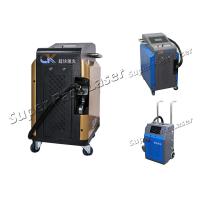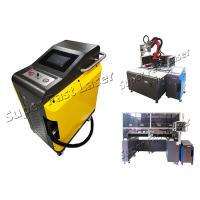50W Rubber Seal Mould Laser Cleaning Machine Silicone Rubber Mold
Laser Remover
| Item | L/N | Characteristics | Test Conditions | Min. | Typical | Max. | Unit |
| Electrical Characteristics | 1 | Power Voltage | 220 | 210 | 220 | 230 | AC |
| 2 | Maximum current loss | Pout=Pnom | 4 | 5 | 6 | A |
| 3 | Total Power | 400 | 390 | 400 | 410 | W |
| 4 | Fiber Cable | 5 | 5 | 5 | 8 | M |
| General Characteristics | 1 | Working temperature range | 0 | / | 60 | ℃ |
| 2 | Storage temperature | -10 | / | 60 | ℃ |
| 3 | Laser power | 50 | W |
| 4 | Peak power | >10KW | KW |
| 5 | Cooling method | Air Cooling | |
| 6 | Laser level | 4 Class | |
| 7 | Pulse energy | 1.5mJ | mJ |
| 8 | Laser wavelength | 1064 | nm |
| 9 | Preheat time | Reach to start operation | 0 | s |
| Achieve complete stability | 10 |
| 10 | Humidity | 10 | / | 95 | % |
| 11 | Laser machine size | L462*W260*H562 (855mm with pull rod) | mm |
| 12 | Weight | 30 | kg |
Where it is used
As well as being able to clean objects which have developed surface
corrosion that needs to be removed, such as metal tools, it is also
possible to use laser cleaning as a means of preparing the surface
of a material before it undergoes another form of processing. This
might include priming prior to the application of paint, or the
removal of excess debris in anticipation of welding.
Of course these are uses in which the precision of the fiber laser
cleaning process is not really put to the test. To demonstrate the
true extent of its abilities, it is worth looking at how it is
applied in the context of cleaning silicon wavers in electronics
manufacturing.
There are a number of ways in which pulsed fiber lasers can clean
surfaces during semiconductor production, whether purely through
photothermal ablation or by use of a type of steam cleaning that is
still far more eco-friendly than any other method available.
As fiber lasers can be precisely controlled for a variety of
applications, it makes sense that they are similarly adaptable for
cleaning purposes.
Secondly, if a deeper clean is necessary, a fiber laser can be used
to completely ablate the top layer of the material itself, exposing
the untainted layer beneath.
This versatility means that it can take on cleaning duties across a
wide range of materials, including those with textured surfaces
which could not withstand alternative methods involving chemicals
or physical contact of any kind. Add to that the other advantages
such as its speed, efficiency and repeatability and it quickly
becomes obvious why this is preferable in a cavalcade of industrial
and manufacturing settings.
As mentioned, there were other forms of cleaning process available
to industries, such as dry-ice blasting, media blasting or cleaning
using chemical solvents, which were perfectly adequate at
completing the job at hand. The problem was that these processes
came with many unwanted side effects too.
The biggest problem with these methods is that they are abrasive
and potentially hazardous. Not only does this have environmental
issues, but it also has safety issues too, as a significant amount
of potentially harmful waste is often created from one of these
more traditional cleaning methods.
The specific problems with the other three types of cleaning
processes are:
• Cleaning using dry-ice blasting – Not efficient at cleaning
delicate surfaces, and a noisy process. Also, potentially hazardous
to
Furthermore, both dry-ice blasting and chemical cleaning have low
levels of automation, making them a process for which the user has
to get heavily involved. Media blasting is slightly different,
having a medium to the high level of automation.
• Cleaning using media blasting – Highly abrasive to substrates,
and so can’t be used on delicate surfaces. It also produces a high
level of waste in the form of blasting media such as sand or
plastic, that also needs to be disposed of
• Cleaning with chemical solvents – A high amount of waste is
created that needs to be disposed of safely. This waste consists of
hazardous solvents that have been mixed with residue, and the
vapors released can be dangerous to humans, hence the operator
requires protection








